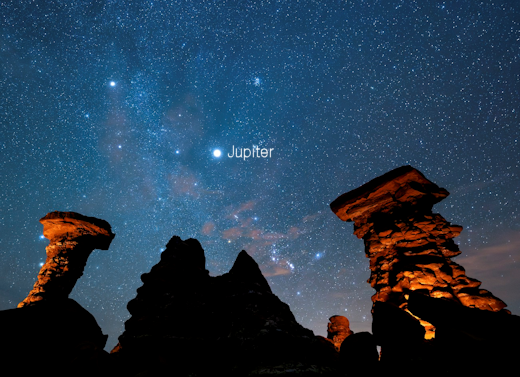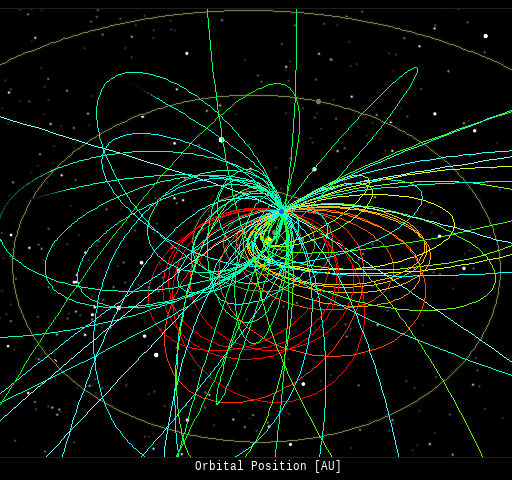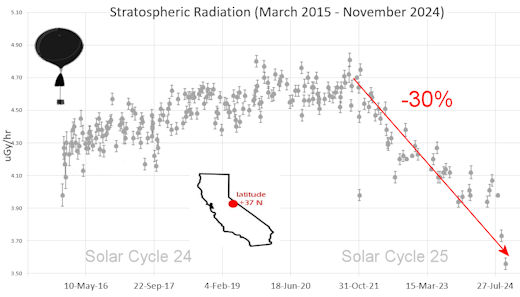This is an AI Free Zone! Text created by Large Language Models is spreading rapidly across the Internet. It's well-written, but frequently inaccurate. If you find a mistake on Spaceweather.com, rest assured it was made by a real human being. | | |
SUNSET SKY SHOW: When the sun goes down tonight, step outside and look southwest. Venus and the crescent Moon are having a close encounter in the sunset sky. It's a beautiful way to end the day! [sky map]
JUPITER OUTSHINES THE STARS: See that very bright star at midnight? It's no star. This week, Jupiter outshines everything else in the midnight sky as it makes its annual closest approach to Earth. Look for it between the horns of Taurus the Bull: sky map.

Jupiter over Bluff, Utah, on Dec. 1st. Credit: Paul Martini.
Shining at magnitude -2.8, Jupiter is almost four times brighter than Sirius. Only the sun, Moon and Venus are brighter than the giant planet this week.
Astronomers call this event "opposition," because Jupiter and the sun are on opposite sides of Earth. This diagram explains it all. During the nights around opposition, Jupiter rises in the east at sunset and soars nearly overhead at midnight; it's up all night. The precise moment of closest approach occurs on Dec. 6th, but Jupiter will be extra big and bright all week long.
Photographers, submit your images here!
A MASSIVE THUNDERSTORM ON JUPITER: Jupiter's proximity to Earth is making it easy to see weather on the giant planet. Right now, a massive thunderstorm is brewing, circled in this Nov. 30th image from Austrian astrophotographer Michael Karrer:

"I took the picture using my 8-inch Celestron telescope," says Karrer. "There is a big outbreak in the South Equatorial Belt (SEB)."
"The white plumes are giant thunderstorms," explains John Rogers of the British Astronomical Association. "They're fairly rare. The last time we saw storms like this was 8 years ago in 2016-17."
Like thunderstorms on Earth, thunderstorms on Jupiter are powered by convection. These are rising up from a location ~50 km below the brown cloudtops. Rogers believes the storms could spread rapidly through the SEB, causing the familiar brown belt to fade as its color is diluted by the white storm front.
Realtime Space Weather Photo Gallery
Free: Spaceweather.com Newsletter
CHRISTMAS GIFTS FROM THE EDGE OF SPACE: Christmas is coming. Are you looking for a far-out gift? Check out the Earth to Sky Store. It's filled with unique items that have flown to the edge of space onboard cosmic ray research balloons.

Carried aloft by giant helium balloons, these unique gifts have flown above 99.7% of Earth's atmosphere, experiencing space-like blasts of cosmic rays, extreme cold, and a wild ride parachuting back to Earth after the balloon explodes. Even Amazon doesn't carry items this far out.
Don't forget to enter coupon code "BLACKCAT" at checkout for a 10% holiday discount.
Far Out Gifts: Earth to Sky Store
All sales support hands-on STEM education
UNUSUAL LIGHT PILLARS: This report is for connoisseurs of light pillars. Light pillars are a common sight during winter when artificial lights bounce off ice crystals suspended in the air. They look like this. The light pillars Angela M. saw this weekend at an airport in Finland, however, were not common:

Note the flared tops. That's what's unusual. Ordinary light pillars shoot straight into the sky with pointy tips. The V-shaped tops of these pillars are extremely rare.
The vast majority of light pillars are caused by ice crystals that look like tiny microscopic plates. However, ice crystals floating around the Rovaniemi airport were not little plates; instead, they were little pencils. Pencil-shaped ice crystals create the flare. To see the shape, common crystal plates must be absent. No one knows where they went! So there is an element of mystery, as well.
Realtime Space Weather Photo Gallery
Free: Spaceweather.com Newsletter
Realtime Comet Photo Gallery
Free: Spaceweather.com Newsletter
Realtime Aurora Photo Gallery
Free: Spaceweather.com Newsletter
Every night, a network of
NASA all-sky cameras scans the skies above the United States for meteoritic fireballs. Automated software maintained by NASA's Meteoroid Environment Office calculates their orbits, velocity, penetration depth in Earth's atmosphere and many other characteristics. Daily results are presented here on Spaceweather.com.
On Dec 04, 2024, the network reported 49 fireballs.
(37 sporadics, 7 sigma Hydrids, 2 November omega Orionids, 1 alpha Canis Majorid, 1 Puppids Velid, 1 Geminid)

In this diagram of the inner solar system, all of the fireball orbits intersect at a single point--Earth. The orbits are color-coded by velocity, from slow (red) to fast (blue). [Larger image] [movies]
Potentially Hazardous Asteroids (
PHAs) are space rocks larger than approximately 100m that can come closer to Earth than 0.05 AU. None of the known PHAs is on a collision course with our planet, although astronomers are finding
new ones all the time.
On December 4, 2024 there were 2349 potentially hazardous asteroids.
 |
Recent & Upcoming Earth-asteroid encounters: | Asteroid | Date(UT) | Miss Distance | Velocity (km/s) | Diameter (m) |
| 2024 WF5 | 2024-Nov-29 | 0.4 LD | 21.4 | 8 |
| 2024 XE2 | 2024-Nov-29 | 8.3 LD | 6.9 | 17 |
| 2018 DC4 | 2024-Nov-29 | 18.8 LD | 4.5 | 12 |
| 2024 XB | 2024-Nov-29 | 3.3 LD | 11.2 | 22 |
| 2024 WZ | 2024-Nov-29 | 3.8 LD | 9.9 | 14 |
| 2019 JN2 | 2024-Nov-30 | 9.4 LD | 7.7 | 25 |
| 2024 WS | 2024-Nov-30 | 6.1 LD | 10.5 | 18 |
| 2024 XF1 | 2024-Nov-30 | 4.5 LD | 22.8 | 26 |
| 2024 XX | 2024-Nov-30 | 1 LD | 7.9 | 16 |
| 2024 XM1 | 2024-Nov-30 | 5.3 LD | 10.9 | 9 |
| 2024 XK | 2024-Dec-01 | 1 LD | 13.8 | 7 |
| 2024 XA | 2024-Dec-01 | 0 LD | 13.6 | 2 |
| 2024 XJ1 | 2024-Dec-01 | 14.7 LD | 6.4 | 16 |
| 2024 WN4 | 2024-Dec-02 | 4.6 LD | 11.5 | 15 |
| 2021 XZ | 2024-Dec-02 | 13.2 LD | 7.4 | 8 |
| 2024 XJ | 2024-Dec-02 | 1.3 LD | 5.5 | 10 |
| 2024 XH1 | 2024-Dec-02 | 0.3 LD | 13.6 | 10 |
| 2024 WL6 | 2024-Dec-03 | 3.9 LD | 8.2 | 20 |
| 2024 XG | 2024-Dec-03 | 3.1 LD | 7.6 | 7 |
| 447755 | 2024-Dec-03 | 14.4 LD | 12.2 | 402 |
| 2020 XR | 2024-Dec-04 | 5.8 LD | 12.3 | 388 |
| 2024 XH | 2024-Dec-04 | 0.9 LD | 11.1 | 12 |
| 2024 WC18 | 2024-Dec-04 | 4.3 LD | 7.8 | 25 |
| 2024 WO1 | 2024-Dec-04 | 11.8 LD | 4.3 | 15 |
| 2024 XC2 | 2024-Dec-04 | 5.6 LD | 4.3 | 11 |
| 2024 WL11 | 2024-Dec-04 | 4.9 LD | 8.5 | 14 |
| 2021 WA5 | 2024-Dec-05 | 9.8 LD | 5.9 | 12 |
| 2024 WA22 | 2024-Dec-05 | 5.7 LD | 2.6 | 12 |
| 2024 WG5 | 2024-Dec-05 | 12 LD | 9.8 | 22 |
| 2024 WB1 | 2024-Dec-05 | 19.1 LD | 5.8 | 22 |
| 2024 WH6 | 2024-Dec-06 | 6.3 LD | 12 | 11 |
| 2024 XB1 | 2024-Dec-06 | 2.3 LD | 6.9 | 11 |
| 2024 WG3 | 2024-Dec-07 | 18.4 LD | 6.5 | 38 |
| 2024 WH12 | 2024-Dec-07 | 6 LD | 6.9 | 14 |
| 2024 WH11 | 2024-Dec-08 | 15.6 LD | 12.2 | 27 |
| 2024 XT | 2024-Dec-08 | 7.5 LD | 14.8 | 13 |
| 2024 UU3 | 2024-Dec-08 | 16.9 LD | 4.8 | 41 |
| 2024 VE13 | 2024-Dec-09 | 18.1 LD | 10.2 | 66 |
| 2024 XG2 | 2024-Dec-09 | 8.9 LD | 12 | 12 |
| 2024 WZ13 | 2024-Dec-10 | 6.9 LD | 8.9 | 20 |
| 2024 WS17 | 2024-Dec-10 | 4.7 LD | 8.3 | 17 |
| 2018 XU3 | 2024-Dec-11 | 16.8 LD | 10.8 | 28 |
| 2024 XK1 | 2024-Dec-11 | 4.9 LD | 7.5 | 10 |
| 2024 WB14 | 2024-Dec-11 | 18.1 LD | 6.5 | 29 |
| 2007 XB23 | 2024-Dec-11 | 1.2 LD | 4.8 | 14 |
| 2024 WP11 | 2024-Dec-12 | 15.6 LD | 8.6 | 21 |
| 2024 XS | 2024-Dec-12 | 8.3 LD | 25.4 | 30 |
| 2024 WD18 | 2024-Dec-13 | 20 LD | 9 | 31 |
| 2024 VE7 | 2024-Dec-16 | 7.3 LD | 8 | 44 |
| 2022 YO1 | 2024-Dec-17 | 2 LD | 14.3 | 4 |
| 2020 XY4 | 2024-Dec-19 | 12.8 LD | 8.8 | 14 |
| 2024 XN1 | 2024-Dec-24 | 18.9 LD | 6.6 | 40 |
| 2017 YD2 | 2024-Dec-27 | 18 LD | 9.9 | 6 |
| 2024 AV2 | 2024-Dec-31 | 6.7 LD | 7.8 | 17 |
| 2021 AO4 | 2025-Jan-04 | 6.9 LD | 15.1 | 11 |
| 2020 BC6 | 2025-Jan-05 | 9.6 LD | 22.2 | 248 |
| 2024 BM1 | 2025-Jan-08 | 11.5 LD | 9.1 | 22 |
| 2024 PT5 | 2025-Jan-09 | 4.7 LD | 1 | 12 |
| 2023 OS3 | 2025-Jan-09 | 19.9 LD | 3.1 | 10 |
| 2012 UK171 | 2025-Jan-11 | 10.7 LD | 6.4 | 46 |
| 2023 OS | 2025-Jan-15 | 16.6 LD | 10.9 | 48 |
| 2022 CE2 | 2025-Jan-16 | 11.1 LD | 13.3 | 120 |
| 2022 OB5 | 2025-Jan-18 | 8.9 LD | 1.4 | 6 |
| 2022 BX6 | 2025-Jan-28 | 19.7 LD | 14.3 | 24 |
| 2015 DJ155 | 2025-Jan-31 | 18.6 LD | 9.2 | 56 |
Notes: LD means "Lunar Distance." 1 LD = 384,401 km, the distance between Earth and the Moon. 1 LD also equals 0.00256 AU. | | Cosmic Rays in the Atmosphere |
SPACE WEATHER BALLOON DATA: Almost once a week, Spaceweather.com and the students of Earth to Sky Calculus fly space weather balloons to the stratosphere over California. These balloons are equipped with sensors that detect secondary cosmic rays, a form of radiation from space that can penetrate all the way down to Earth's surface. Our monitoring program has been underway without interruption for 10 years, resulting in a unique dataset of in situ atmospheric measurements.
Latest results (Nov. 2024): Atmospheric radiation is decreasing in 2024. Our latest measurements in November registered a 10-year low:

What's going on? Ironically, the radiation drop is caused by increasing solar activity. Solar Cycle 25 has roared to life faster than forecasters expected. The sun's strengthening and increasingly tangled magnetic field repels cosmic rays from deep space. In addition, solar coronal mass ejections (CMEs) sweep aside cosmic rays, causing sharp reductions called "Forbush Decreases." The two effects blend together to bring daily radiation levels down.
.Who cares? Cosmic rays are a surprisingly "down to Earth" form of space weather. They can alter the chemistry of the atmosphere, trigger lightning, and penetrate commercial airplanes. According to a study from the Harvard T.H. Chan school of public health, crews of aircraft have higher rates of cancer than the general population. The researchers listed cosmic rays, irregular sleep habits, and chemical contaminants as leading risk factors. A number of controversial studies (#1, #2, #3, #4) go even further, linking cosmic rays with cardiac arrhythmias and sudden cardiac death.
Technical notes: The radiation sensors onboard our helium balloons detect X-rays and gamma-rays in the energy range 10 keV to 20 MeV. These energies span the range of medical X-ray machines and airport security scanners.
Data points in the graph labeled "Stratospheric Radiation" correspond to the peak of the Regener-Pfotzer maximum, which lies about 67,000 feet above central California. When cosmic rays crash into Earth's atmosphere, they produce a spray of secondary particles that is most intense at the entrance to the stratosphere. Physicists Eric Regener and Georg Pfotzer discovered the maximum using balloons in the 1930s and it is what we are measuring today.
| | The official U.S. government space weather bureau |
| | The first place to look for information about sundogs, pillars, rainbows and related phenomena. |
| | Researchers call it a "Hubble for the sun." SDO is the most advanced solar observatory ever. |
| | 3D views of the sun from NASA's Solar and Terrestrial Relations Observatory |
| | Realtime and archival images of the Sun from SOHO. |
| | information about sunspots based on the latest NOAA/USAF Active Region Summary |
| | current counts of failed and deployed Starlink satellites from Jonathan's Space Page. See also, all satellite statistics. |
| | Authoritative predictions of space junk and satellite re-entries |
| | from the NOAA Space Environment Center |
| | fun to read, but should be taken with a grain of salt! Forecasts looking ahead more than a few days are often wrong. |
| | from the NOAA Space Environment Center |
| | the underlying science of space weather |
 | Got a chipped or cracked windshield that prevents you from seeing space weather events while driving? Get windshield replacement from SR Windows & Glass with free mobile auto glass service anywhere in the Phoenix area. |
 | BestCSGOGambling is the best site for everything related to CSGO gambling on the web |
| | These links help Spaceweather.com stay online. Thank you to our supporters! |
| | | | | | |

